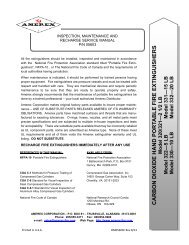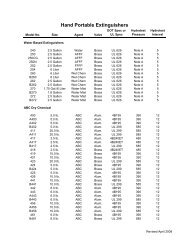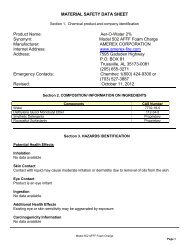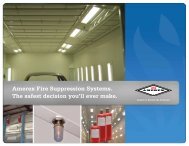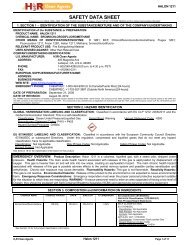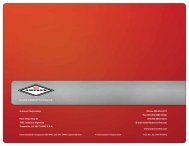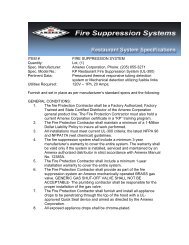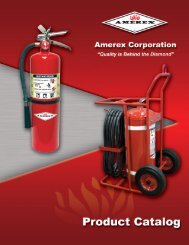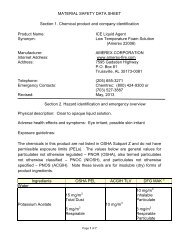Manual for Class D wheeled extinguishers.pdf - Amerex Corporation
Manual for Class D wheeled extinguishers.pdf - Amerex Corporation
Manual for Class D wheeled extinguishers.pdf - Amerex Corporation
Create successful ePaper yourself
Turn your PDF publications into a flip-book with our unique Google optimized e-Paper software.
OPERATION<br />
CAUTION: PERSONS EXPECTED TO USE THIS EXTINGUISHER SHOULD BE TRAINED IN INITIATING ITS OPERATION<br />
AND IN THE PROPER FIRE FIGHTING TECHNIQUE. FAMILIARIZE ALL PERSONNEL WITH THIS INFORMA-<br />
TION BEFORE AN EMERGENCY OCCURS.<br />
1. Move the extinguisher to within approximately 25 feet of the fire site. REMOVE RING<br />
(SAFETY) PIN.<br />
Pull “T” handle to OPEN ARGON VALVE. This will pressurize the extinguisher.<br />
2. Remove nozzle from the mount, and with the nozzle lever in the CLOSED position,<br />
PULL HOSE FROM RACK AND START BACK 15 FEET from the fire.<br />
Note: When using the wand applicator START BACK 6 FEET FROM FIRE.<br />
3. OPEN NOZZLE SHUT-OFF slowly by pulling handle fully towards you (hold the nozzle<br />
firmly and be prepared <strong>for</strong> a discharge recoil). COVER ALL BURNING METAL WITH<br />
POWDER.<br />
4. REAPPLY AGENT TO HOT SPOTS until the fire is fully extinguished.<br />
DISCHARGE TIME (APPROXIMATE)<br />
Model 680 – 80 Seconds Model 681 – 120 Seconds<br />
EFFECTIVE RANGE OF THE AGENT THROW<br />
With Nozzle (both units) – 20 to 30 feet<br />
With Applicator (both units) – 4 to 6 feet<br />
HOSE LENGTH - 25 FEET<br />
RECHARGE EXTINGUISHER IMMEDIATELY AFTER ANY USE <br />
SHUTDOWN<br />
1. After making sure that the fire has been completely extinguished, push the nozzle lever <strong>for</strong>ward to the CLOSED<br />
position.<br />
2. Close the Argon cylinder valve (push “T” handle to closed position).<br />
3. Tip extinguisher over to rest on wheels and handle, then slowly open the nozzle lever again to clear the hose of<br />
chemical agent and pressure (be prepared <strong>for</strong> recoil and discharge of agent).<br />
WARNING: MAKE SURE THAT ALL PRESSURE HAS ESCAPED BEFORE FURTHER DISASSEMBLY.<br />
4. Stand the extinguisher upright after complete depressurization.<br />
Note: Argon pressure in the agent cylinder cannot escape through a disconnected pressurizing hose due to a<br />
check valve in the system. Always be careful when removing the fill cap.<br />
5. Coil the extinguisher hose onto the storage rack and position the nozzle (and/or Extension Wand) onto the<br />
mount in preparation <strong>for</strong> transport to the recharge location.<br />
WARNING: THE SHIPPING CAP MUST BE INSTALLED ON THE ARGON CYLINDER PRIOR TO TRANSPORT<br />
TO THE RECHARGE LOCATION.<br />
INSPECTING THE EXTINGUISHER<br />
INSPECTION (NFPA-10 4.2.1) is a “quick check” that an extinguisher is available and will operate. It is intended to give<br />
reasonable assurance that the extinguisher is fully charged and operable. This is done by seeing that it is in its<br />
designed place, that it has not bee actuated or tampered with, and that there is no obvious physical damage or<br />
condition to prevent operation.



